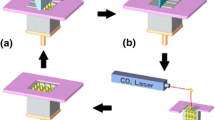Abstract
Potential porous calcium silicate (CaSiO3) scaffolds for bone tissue engineering were successfully prepared by 3D gel printing technology. The average particle size of CaSiO3 powder is about 5.119 μm. The CaSiO3 slurry prepared for printing had been exhibited shear-thinning properties, and the maximum solid loading of the slurry was 72 wt%. The green scaffolds were sintered at 1150 °C for 4 h after degreasing at 250 °C for 3 h, 420 °C for 9 h, and 660 °C for 3 h, respectively. The sintered scaffolds have well-distributed designed voids and microporous. The shrinkage in length, width, and height is 12.29 ± 0.20%, 12.43 ± 0.17%, 13.15 ± 0.19%, respectively. The porosity of the sintered scaffold is approximately 62%, and the compressive strength is about 16.52 MPa, which is equivalent to the strength of human cancellous bone.











Similar content being viewed by others
References
Hench LL, Thompson I (2010) Twenty-first century challenges for biomaterials. J R Soc Interface 7(Suppl 4):S379–S391
Chu PK, Tang BY, Wang LP, Wang XF, Wang SY, Huang N (2001) Third-generation plasma immersion ion implanter for biomedical materials and research. Rev Sci Instrum 72:1660–1665
Yeong WY, Chua CK, Leong KF, Chandrasekaran M (2004) Rapid prototyping in tissue engineering: challenges and potential. Trends Biotechnol 22:643–652
Reena A, Bhatt MD, Tamara D, Rozental MD (2012) Bone graft substitutes. Hand Clin 4:457–468
Yang J, Cai H, Lv J, Zhang K, Leng H, Sun C (2014) In vivo study of a self-stabilizing artificial vertebral body fabricated by electron beam melting. Spine 39:E486–E492
Xu M, Zhai D, Chang J, Wu C (2014) In vitro assessment of three-dimensionally plotted nagelschmidtite bioceramic scaffolds with varied macropore morphologies. Acta Biomater 10:463–476
Hollister SJ (2005) Porous scaffold design for tissue engineering. Nat Mater 4:518–524
Kokubo T (1991) Bioactive glass ceramics: properties and applications. Biomaterials 12:155–163
Wu C, Chang J (2010) Degradation, bioactivity, and cytocompatibility of diopside, akermanite, and bredigite ceramics. J Biomed Mater Res B Appl Biomater 83B:153–160
Xu S, Lin K, Wang Z, Chang J, Wang L, Lu J (2008) Reconstruction of calvarial defect of rabbits using porous calcium silicate bioactive ceramics. Biomaterials 29:2588–2596
Schwarz K, Milne DB (1972) Growth-promoting effects of silicon in rats. Nature 239:333–334
Duan B, Wang M, Zhou WY, Cheung WL, Li ZY, Lu WW (2010) Three-dimensional nanocomposite scaffolds fabricated via selective laser sintering for bone tissue engineering. Acta Biomater 6:4495–4505
Tong HW, Wang M (2010) Electrospinning of fibrous polymer scaffolds using positive voltage or negative voltage: a comparative study. Biomed Mater 5:054110–054124
Guarino V, Causa F, Taddei P, Di FM, Ciapetti G, Martini D (2008) Polylactic acid fibre-reinforced polycaprolactone scaffolds for bone tissue engineering. Biomaterials 29:3662–3670
Fan H, Tao H, Wu Y, Hu Y, Yan Y, Luo Z (2010) Tgf-β3 immobilized plga-gelatin/chondroitin sulfate/hyaluronic acid hybrid scaffold for cartilage regeneration. J Biomed Mater Res Part A 95:982–992
Ren X, Shao H, Lin T, Zheng H (2016) 3D gel-printing—an additive manufacturing method for producing complex shape parts. Mater Des 101:80–87
Shao H, Zhao D, Lin T, He J, Wu J (2017) 3D gel-printing of zirconia ceramic parts. Ceram Int 43:13938–13942
Shao H, He J, Lin T, Zhang Z, Zhang Y, Liu S (2019) 3D gel-printing of hydroxyapatite scaffold for bone tissue engineering. Ceram Int 45:1163–1170
Acknowledgements
This work was supported by the Key Research and Development Projects of the People’s Liberation Army (No. BWS17J036).
Author information
Authors and Affiliations
Corresponding author
Additional information
Publisher's Note
Springer Nature remains neutral with regard to jurisdictional claims in published maps and institutional affiliations.
Rights and permissions
About this article
Cite this article
Zhang, Z., Shao, H., Lin, T. et al. 3D gel printing of porous calcium silicate scaffold for bone tissue engineering. J Mater Sci 54, 10430–10436 (2019). https://doi.org/10.1007/s10853-019-03626-1
Received:
Accepted:
Published:
Issue Date:
DOI: https://doi.org/10.1007/s10853-019-03626-1




